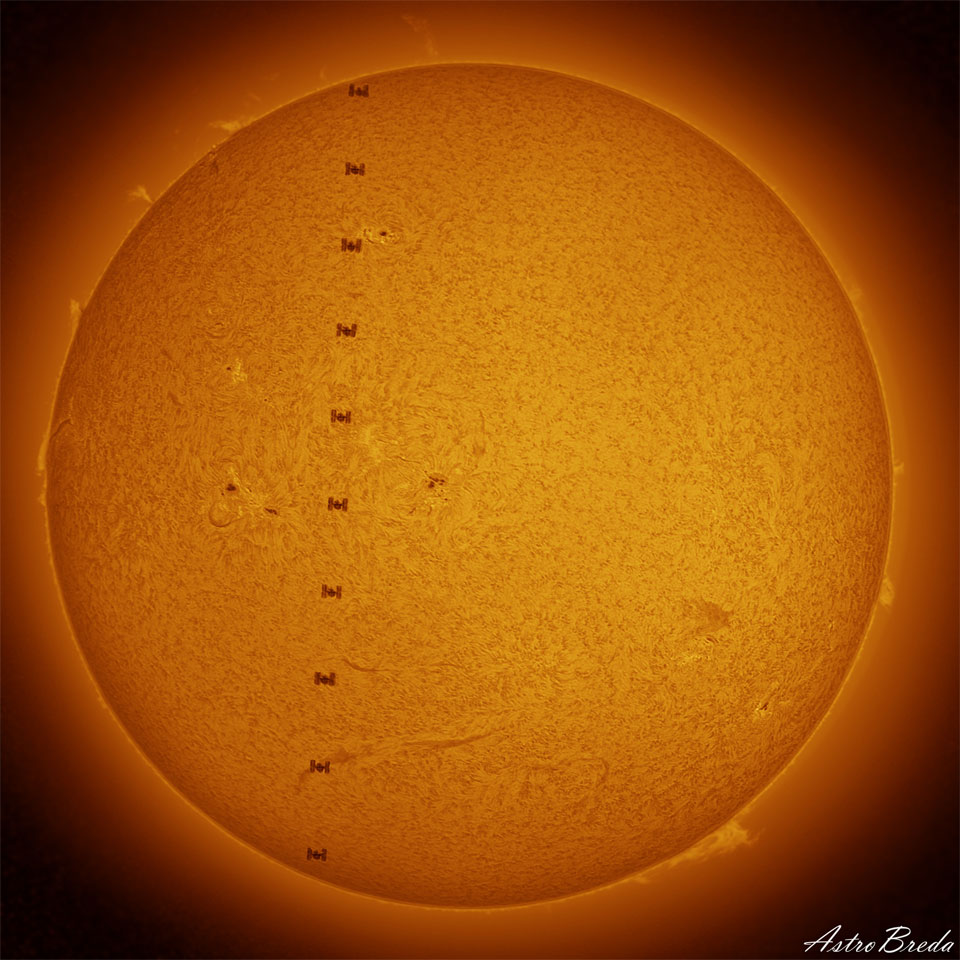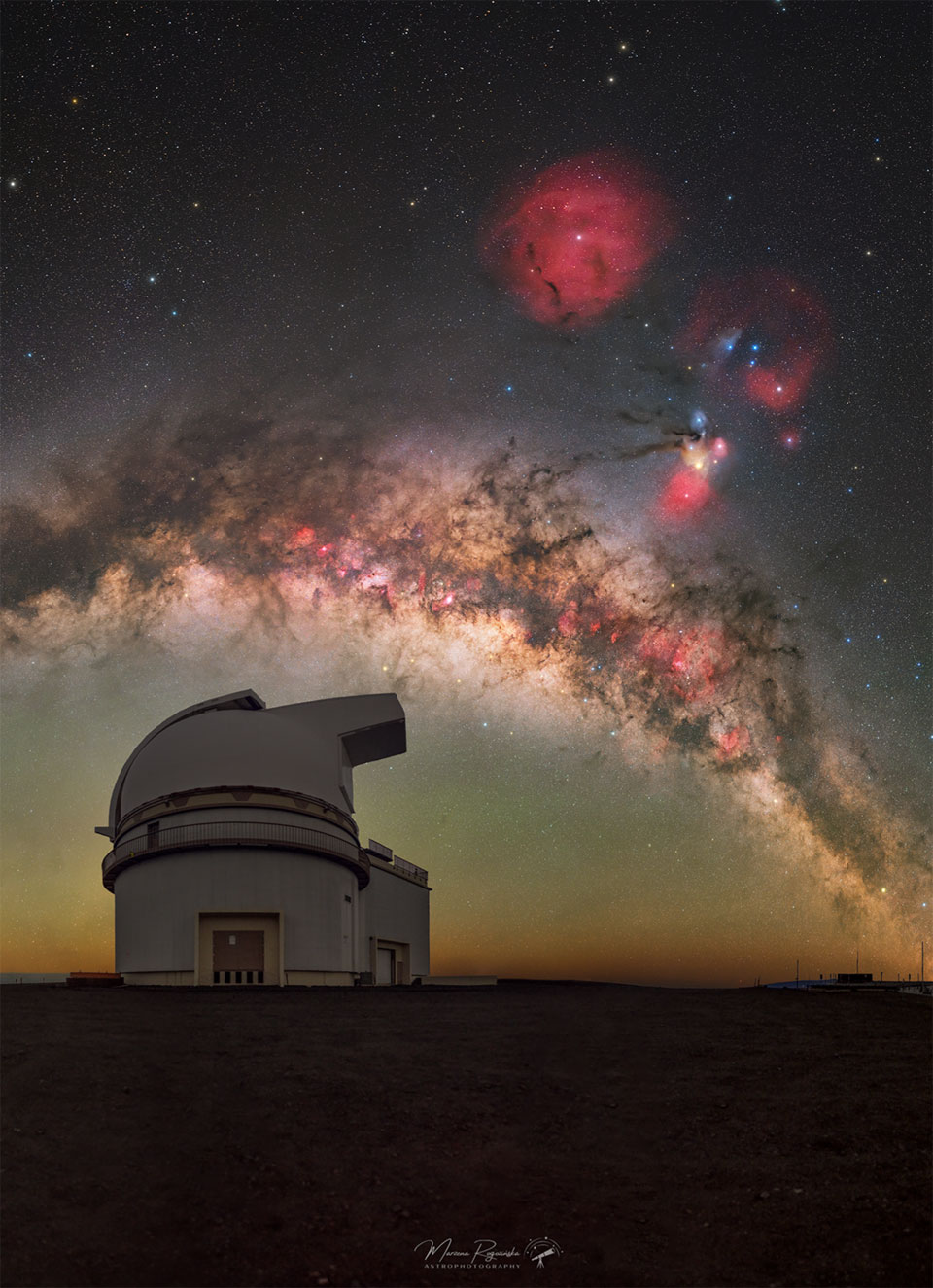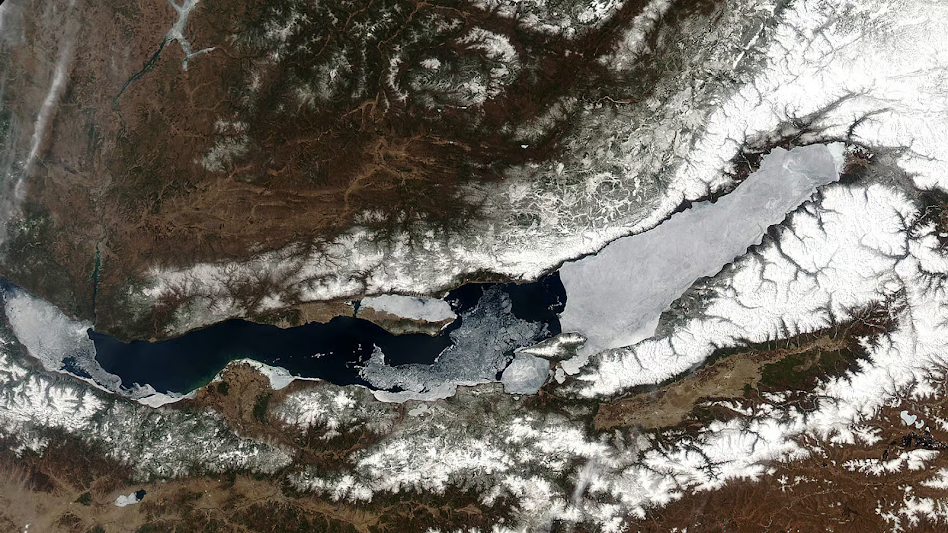Nombre total de pages vues
21/05/2025
LA TERRE VUE DU CIEL - Lever de Lune au-dessus du Pacifique par la sonde Rosetta
ASTRONOMY - International Space Station Crosses the Sun
2025 May 21
Image Credit & Copyright: Pau Montplet Sanz
Explanation: Typically, the International Space Station is visible only at night. Slowly drifting across the night sky as it orbits the Earth, the International Space Station (ISS) can be seen as a bright spot about once a month from many locations. The ISS is then visible only just after sunset or just before sunrise because it shines by reflected sunlight -- once the ISS enters the Earth's shadow, it will drop out of sight. The only occasion when the ISS is visible during the day is when it passes right in front of the Sun. Then, it passes so quickly that only cameras taking short exposures can visually freeze the ISS's silhouette onto the background Sun. The featured picture did exactly that -- it is actually a series of images taken a month ago from Sant Feliu de Buixalleu, Spain with perfect timing. This image series was later combined with a separate image highlighting the texture of the active Sun which included several Sun's prominences around the edge.
20/05/2025
RADIOACTIVITé - Contamination à Fessenheim : les travailleurs sont-ils assez protégés ?
ASTRONOMY - Milky Way over Maunakea
2025 May 20
Image Credit & Copyright: Marzena Rogozinska
Explanation: Have you ever seen the band of our Milky Way Galaxy? In a clear sky from a dark location at the right time, a faint band of light becomes visible across the sky. Soon after your eyes become dark adapted, you might spot the band for the first time. It may then become obvious. Then spectacular. One reason for your growing astonishment might be the realization that this fuzzy swath, the Milky Way, contains billions of stars. Visible in the featured image, high above in the night sky, the band of the Milky Way Galaxy arcs. Also visible are the colorful clouds of Rho Ophiuchi on the right, and the red and circular Zeta Ophiuchi nebula near the top center. Taken in late February from Maunakea, Hawaii, USA, the foreground telescope is the University of Hawaii's 2.2-Meter Telescope. Fortunately, you don’t need to be near the top of a Hawaiian volcano to see the Milky Way.
19/05/2025
ASTRONOMY - Charon Flyover from New Horizons
2025 May 19
SANTé/MEDECINE - L'ADN des bactéries -
18/05/2025
LA TERRE VUE DU CIEL - Le printemps du lac Baïkal
ASTRONOMY - Pluto Flyover from New Horizons
Video Credit: NASA, JHUAPL, SwRI, P. Schenk & J. Blackwell (LPI); Music Open Sea Morning by Puddle of Infinity
Explanation: What if you could fly over Pluto -- what might you see? The New Horizons spacecraft did just this in 2015 July as it shot past the distant world at a speed of about 80,000 kilometers per hour. Images from this spectacular passage have been color enhanced, vertically scaled, and digitally combined into the featured two-minute time-lapse video. As your journey begins, light dawns on mountains thought to be composed of water ice but colored by frozen nitrogen. Soon, to your right, you see a flat sea of mostly solid nitrogen that has segmented into strange polygons that are thought to have bubbled up from a comparatively warm interior. Craters and ice mountains are common sights below. The video dims and ends over terrain dubbed bladed because it shows 500-meter high ridges separated by kilometer-sized gaps. The robotic New Horizons spacecraft has too much momentum to ever return to Pluto and is now headed out of our Solar System.
16/05/2025
ASTRONOMY - Messier 101
2025 May 16
Image Credit: NASA, ESA, CFHT, NOAO;
Acknowledgement - K.Kuntz (GSFC), F.Bresolin (U.Hawaii), J.Trauger (JPL), J.Mould (NOAO), Y.-H.Chu (U. Illinois)
Explanation: Big, beautiful spiral galaxy M101 is one of the last entries in Charles Messier's famous catalog, but definitely not one of the least. About 170,000 light-years across, this galaxy is enormous, almost twice the size of our own Milky Way. M101 was also one of the original spiral nebulae observed by Lord Rosse's large 19th century telescope, the Leviathan of Parsontown. Assembled from 51 exposures recorded by the Hubble Space Telescope in the 20th and 21st centuries, with additional data from ground based telescopes, this mosaic spans about 40,000 light-years across the central region of M101 in one of the highest definition spiral galaxy portraits ever released from Hubble. The sharp image shows stunning features of the galaxy's face-on disk of stars and dust along with background galaxies, some visible right through M101 itself. Also known as the Pinwheel Galaxy, M101 lies within the boundaries of the northern constellation Ursa Major, about 25 million light-years away.
15/05/2025
SANTé/MEDECINE - ADN - Un caryotype coloré grâce à l'hybridation fluorescente (Fish)
SANTé/MEDECINE - LA GUERISON DU CANCER : Un espoir immense - La troisième voie -3/7-
Sous la surface : le cancer, cette mécanique déréglée Pour éviter le discours scolaire, posons le décor sans jargon superflu. Le cancer, à l...

-
2022 September 26 All the Water on Planet Earth Illustration Credit: Jack Cook, Adam Nieman, Woods Hole Oceanographic Institution ; Data ...
-
2025 January 14 North Star: Polaris and Surrounding Dust Image Credit & Copyright: Davide Coverta Explanation: Why is Polaris called ...







